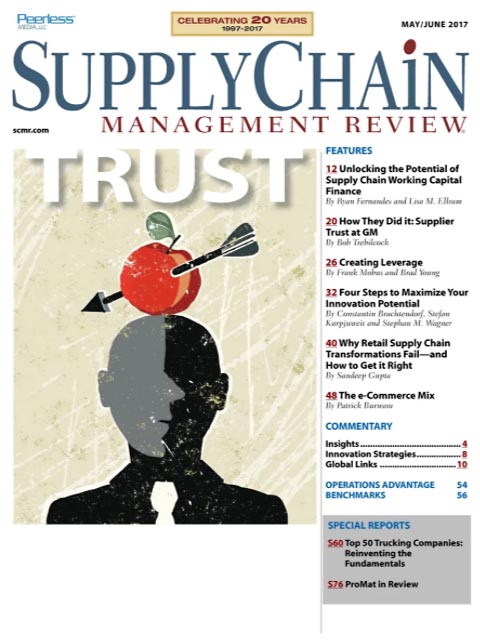Sorry, but your login has failed. Please recheck your login information and resubmit. If your subscription has expired, renew here.
May-June 2017
Trust hasn’t always been an element in supplier relationships; all too often buyers have been encouraged to carry a big stick and get tough with suppliers to get the best price—no matter the cost. That approach to procurement is beginning to change. Browse this issue archive.Need Help? Contact customer service 847-559-7581 More options
Many organizations have adopted analytics initiatives because of their need to aggregate vast amounts of data and to automate the identification of patterns and trends. The supply chain alone produces a large enough data set that analytics can be applied to help identify areas for process and performance improvement. Data generated through internal operations, as well as transactions with suppliers and customers, can be used to uncover small changes that can make a big impact on an organization with regard to efficiency gains and even cost savings.
Many supply chain professionals report that their organizations have increased their investment in analytics over the last three years, according to a recent APQC survey. This survey looked at the analytics practices of organizations, as well as the structure of these efforts. APQC surveyed supply chain professionals from a variety of organization sizes and regions and from 36 industries. APQC’s analysis found that organizations have several areas of focus for their supply chain analytics efforts, and that most organizations have a formal analytics structure. However, the payoff of these efforts may not be at the level organizations expect.
Analytics inputs and outputs
Supply chain organizations focus on a variety of goals for their use of analytics. As shown in Figure 1, when asked about seven possible goals or activities, a majority of respondents highly agree or agree that each goal or activity is an area of focus. This indicates that organizations want to see a variety of results from their supply chain analytics efforts.

This complete article is available to subscribers only.
Log in now for full access or start your PLUS+ subscription for instant access.
SC
MR
Sorry, but your login has failed. Please recheck your login information and resubmit. If your subscription has expired, renew here.
May-June 2017
Trust hasn’t always been an element in supplier relationships; all too often buyers have been encouraged to carry a big stick and get tough with suppliers to get the best price—no matter the cost. That approach to… Browse this issue archive. Access your online digital edition. Download a PDF file of the May-June 2017 issue.Many organizations have adopted analytics initiatives because of their need to aggregate vast amounts of data and to automate the identification of patterns and trends. The supply chain alone produces a large enough data set that analytics can be applied to help identify areas for process and performance improvement. Data generated through internal operations, as well as transactions with suppliers and customers, can be used to uncover small changes that can make a big impact on an organization with regard to efficiency gains and even cost savings.
Many supply chain professionals report that their organizations have increased their investment in analytics over the last three years, according to a recent APQC survey. This survey looked at the analytics practices of organizations, as well as the structure of these efforts. APQC surveyed supply chain professionals from a variety of organization sizes and regions and from 36 industries. APQC's analysis found that organizations have several areas of focus for their supply chain analytics efforts, and that most organizations have a formal analytics structure. However, the payoff of these efforts may not be at the level organizations expect.
Analytics inputs and outputs
Supply chain organizations focus on a variety of goals for their use of analytics. As shown in Figure 1, when asked about seven possible goals or activities, a majority of respondents highly agree or agree that each goal or activity is an area of focus. This indicates that organizations want to see a variety of results from their supply chain analytics efforts.
SC
MR


Latest Supply Chain News
- Few executives believe their supply chains can respond quickly to disruptions
- Technology’s role in mending supply chain fragility after recent disruptions
- Tech investments bring revenue increases, survey finds
- Survey reveals strategies for addressing supply chain, logistics labor shortages
- Israel, Ukraine aid package to increase pressure on aerospace and defense supply chains
- More News
Latest Podcast

 Explore
Explore
Topics
Latest Supply Chain News
- Few executives believe their supply chains can respond quickly to disruptions
- Technology’s role in mending supply chain fragility after recent disruptions
- Tech investments bring revenue increases, survey finds
- Survey reveals strategies for addressing supply chain, logistics labor shortages
- Israel, Ukraine aid package to increase pressure on aerospace and defense supply chains
- How CPG brands can deliver on supplier diversity promises
- More latest news
Latest Resources

Subscribe

Supply Chain Management Review delivers the best industry content.

Editors’ Picks





